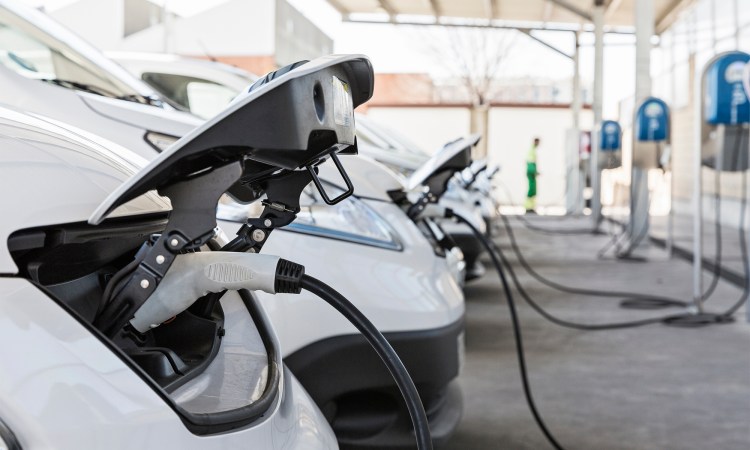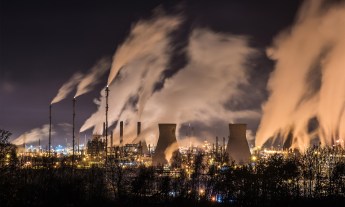
On April 22, US President Joseph R. Biden announced bold new goals to tackle the climate crisis, with the takeaway being this: The US plans to halve greenhouse gas emissions by 2030.
While this may sound incredibly ambitious, it’s exactly the kind of commitment needed to reach net zero by 2050 — which is the ultimate target — and stave off the most severe consequences of climate change: widespread biodiversity loss, food and water insecurity, extreme weather and mass migration.
In 2019, the US produced around 6.6 billion tons of greenhouse gas emissions, making it the world’s second largest emitter after China (followed by India, Russia and Japan). Halving emissions and making a rapid transition to clean energy over the next decade means phasing out fossil fuels, building renewable energy infrastructure, manufacturing electric vehicles and training and mobilizing a skilled workforce.
TED sat down with Nathaniel Keohane — senior vice president of the Environmental Defense Fund and an expert in climate policy and economics — to talk about the new US commitments, what they mean and how we’ll get there.
TED: The White House just announced its Nationally Determined Contribution (NDC). What are NDCs, why do they matter and why are we hearing about them now?
Nathaniel Keohane: In December 2015, 197 countries adopted the landmark Paris climate agreement, an international treaty designed to limit global temperature rise by sharply reducing greenhouse gas emissions. The agreement set up a framework that requires countries to come forward every five years with increasingly ambitious emissions reduction targets, or nationally determined contributions (NDCs). The five-year mark was actually last year, but the annual climate conference (known as COP26) was delayed because of the COVID-19 crisis — so countries are coming forward with those revised NDCs this year instead.
In addition, the US has to submit a new NDC because it just re-entered the agreement after Donald Trump had pulled out. That’s what was announced last week: a target of reducing emissions between 50 to 52 percent below 2005 levels by 2030. That’s the level of ambition needed to get the US on a pathway to net zero emissions by 2050, which is what President Biden announced on the campaign trail and what many other advanced economies have pledged to do. But 2050 is a long way away, so we also need near term targets like 2030.
TED: How do the US targets compare to the ones announced by other countries?
Keohane: Across the rest of the world, we’re seeing a mixed bag of NDCs. China announced more robust language around coal, but didn’t quite make a new commitment. India also did not make new commitments. Canada pledged to reduce emissions 40 to 45 percent below 2005 levels by 2030, Japan announced a 46 percent reduction, and South Korea will announce their target later this year. In general, we’re seeing a lot more ambitious targets, especially from advanced economies, and that’s what we’re going to need to get to net zero by 2050.
TED: How binding are these commitments? In theory, could a future administration overturn them?
Keohane: It depends what country you’re in. The binding parts of the Paris agreement are fairly limited — you’re required to set a target, you have to try to meet it, and you have to report on it. But the way the Paris agreement is designed, the targets are up to the countries themselves — “nationally determined.” That was key to getting all countries to participate in the Paris agreement, rather than only developed countries as in the previous Kyoto Protocol.
We see four areas where there will be a real focus: the power sector, the transport sector, methane emissions from oil and gas, and agriculture.
Other countries do decide to write their targets into law. In Canada, for example, one reason they set a 40 to 45 percent target rather than 50 is because they will have to write that target into a binding law.
In the US context, what will be binding are policies that the US passes into law (or, in the case of regulations, puts in place using authorities under existing law) in pursuit of that target. We need to start putting policies in place that will shift the economy towards clean energy and low carbon infrastructure. We need to build wind turbines and solar panels and strengthen supply chains for electric vehicles.
It’s worth noting in the three years before 2020, US emissions did not increase — rather, they essentially leveled off. That’s in large part because of the momentum we had going into Donald Trump’s presidency from low-carbon investments like those in wind and solar. Similarly, if we’re retooling our factories for the low carbon transition, it will be harder for a future president to reverse course.
TED: Given we’re already a quarter of the way through 2021, is it realistic for the US to halve emissions by 2030?
Keohane: My answer is yes. The new target is credible because we’ve done the math. There’s lots of analysis and modeling out there — by EDF, WRI and the University of Maryland among others — showing that the US can get to a 50 to 52 percent reduction with the right policies. We have an ambitious target and it’s one that can be achieved. Now we need to implement it.
TED: What’s the US plan to cut emissions? Which sectors will be most affected?
Keohane: We see four areas where there will be a real focus: the power sector, the transport sector, methane emissions from oil and gas, and agriculture.
First, the power sector is where we can get the bulk of the emissions reductions we need over the next decade. Modeling suggests the power sector could cut emissions in the US by 80 percent below 2005 levels simply by using existing technologies and phasing out coal. The way forward is pretty clear: build a lot of wind and solar, maintain the existing nuclear fleet, phase out coal on an accelerated basis, and start to phase down natural gas. There’s already a lot of progress to build on, but we need government policy to get there, ideally at the federal level. We need infrastructure investment that Congress can pass this year, in addition to policies like a Clean Electricity Standard that put an enforceable limit on carbon pollution from the power sector.
Methane is 120 times more potent than carbon dioxide … the most important thing the world can do to slow the rate of warming in the next couple of decades is to reduce methane.
Second is transportation, which is now the largest sector in the US for greenhouse gas emissions. President Biden is talking about transitioning the US to having 100 percent of new car sales be emissions-free cars by 2035 and ideally we would see zero-emission trucks by 2040. The way to get there is at first through policies, like tailpipe emission standards based on the availability of zero-emitting vehicles. The Environmental Protection Agency has been setting standards on pollution from tailpipes for decades. Congress can get into the mix too by investing in electric vehicle charging infrastructure and domestic supply chains.
The third sector is methane from oil and gas. Methane is 120 times more potent than carbon dioxide on a pound per pound basis when it’s emitted, but methane degrades in the atmosphere faster than carbon dioxide. That means methane has a powerful impact on near-term warming, while carbon dioxide levels affect long-term temperature. The most important thing the world can do to slow the rate of warming in the next couple of decades is to reduce methane. In the U.S. that means putting in place regulations that cut emissions from the oil and gas supply chain — even as we’re simultaneously working to phase those fuels out over time.
And finally, there’s agriculture. In this sector, there are opportunities to build bipartisan political support. Just last week, the senators Debbie Stabenow (D-Mich.) and John Boozman, (R-Ark.) introduced a bill called the Growing Climate Solutions Act. It’s a bipartisan bill that would help American farmers, ranchers and forest landowners be more resilient to climate change, and also create incentives for them to be part of the solutions by participating in initiatives like carbon capture through soil.
TED: Because of these new targets, what kinds of changes should Americans see in their daily lives between now and 2030?
Keohane: Some things, like in the power sector, are going to be out of sight. You’re still going to get electricity delivered to your house, but how that electricity is produced is going to be different and that’s not something people will see every day. What you might see are more solar panels and wind turbines, and really importantly, you’ll see cleaner air because we won’t be burning fossil fuels, which are a leading source of air pollution in this country.
I don’t think anybody’s going to wake up in 2035 and say, “I wish I was going to a gas station every week and filling my car up with polluting liquid.”
For vehicles and transport, it’s a different story. Electric vehicles are still kind of niche, but we’re going to see that grow tremendously over the coming years — they’ll be the rule rather than the exception. They’re fun to drive, they’ll get more affordable, and they’re easy to maintain. I don’t think anybody’s going to wake up in 2035 and say, “I wish I was going to a gas station every week and filling my car up with polluting liquid.” The shift to cleaner transportation will make a particularly big difference in disadvantaged and low-income communities that have long borne the brunt of toxic air and water pollution. There’s huge inequality in the US in terms of air quality between wealthy areas and poor areas, and transitioning to zero-emitting vehicles and trucks can be a big part of addressing that.
And then there’s the economy. When President Biden introduced the new US targets, he also emphasized the creation of jobs that we’ll start to see — jobs like building a cleaner electric grid, building electric vehicles, manufacturing batteries, having oil and gas workers plugging abandoned oil wells, and construction and manufacturing.
TED: How can people track how the US is doing on meeting its climate goals? And what can everyday citizens do to help?
Keohane: One idea we’ve floated at the Environmental Defense Fund, which is my organization, is putting together a website that will allow everyday folks to track progress, so stay tuned.
In addition to tracking how we’re doing, I think the way for people to get involved is to use your voice. There are a lot of positive outcomes that we’ll experience from a low carbon transition and a clean energy future. Engage your friends, neighbors and family about the importance of action on climate and the opportunities that it brings to our economy and our communities.
Another way to use your voice is by putting climate action at the center of voting decisions, regardless of your political affiliation. We are going to need action from Congress, states and the White House to make these goals stick.
We need to continue to show people that a low carbon economy is a healthier economy. It means cleaner air for them and their kids, it means better jobs and a stronger economy. As we bounce back from the recession induced by the pandemic, it means a more equitable and just economy. If we can show that investments in clean energy have a real impact on people’s lives, we can keep the momentum going. The US has come a long way as a country. It’s good to step back and appreciate that — then roll up our sleeves and get to work.
Watch this TED-Ed Lesson on electricity and the world now:












